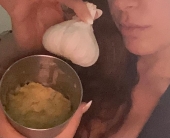A few years ago, I was looking for things to grow in my yard so I can grow chicken food for the winter. Freezing and drying bamboo leaves was the start. Then lambs quarters, but I stopped buying lettuce and spinach, so there is not much to preserve this year. One mullein grew in my yard last year, now that one is at my new permaculture-learning friend's home. My method for introducing wild food is to find seeds and then cast them throughout my tiny yard, which has only partial sun. What grows well changes each year. Last year violets were a bumper crop, dandilions are fewer this year. But I have milkweed where I planted
flax! I plan to collect the fluff and make a small pillow! My neighbor laughed when I told him the mullein was cowboy toilet paper, I told him plantain was good for small skin wounds, and looked high and low and finally found 2 lambsquarter plants. It is everywhere in my yard. Dock is growing in more places, but the chickens don't like it. I was going to try sprouting the seeds next. I apparently am spreading plantain to the driveway, which was dirt which I covered with wood chips to try to reduce desertification, and it appears to be working! So what ever I learn, I plan to continually share with my neighbors and friends. Thanks to all of you that contribute to my learning!
The quantity of birds visiting my yard has increased each of the last few years, and I think the plant varieties are increasing from this (and the non-mowing).









